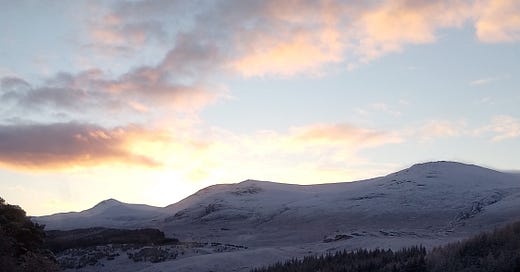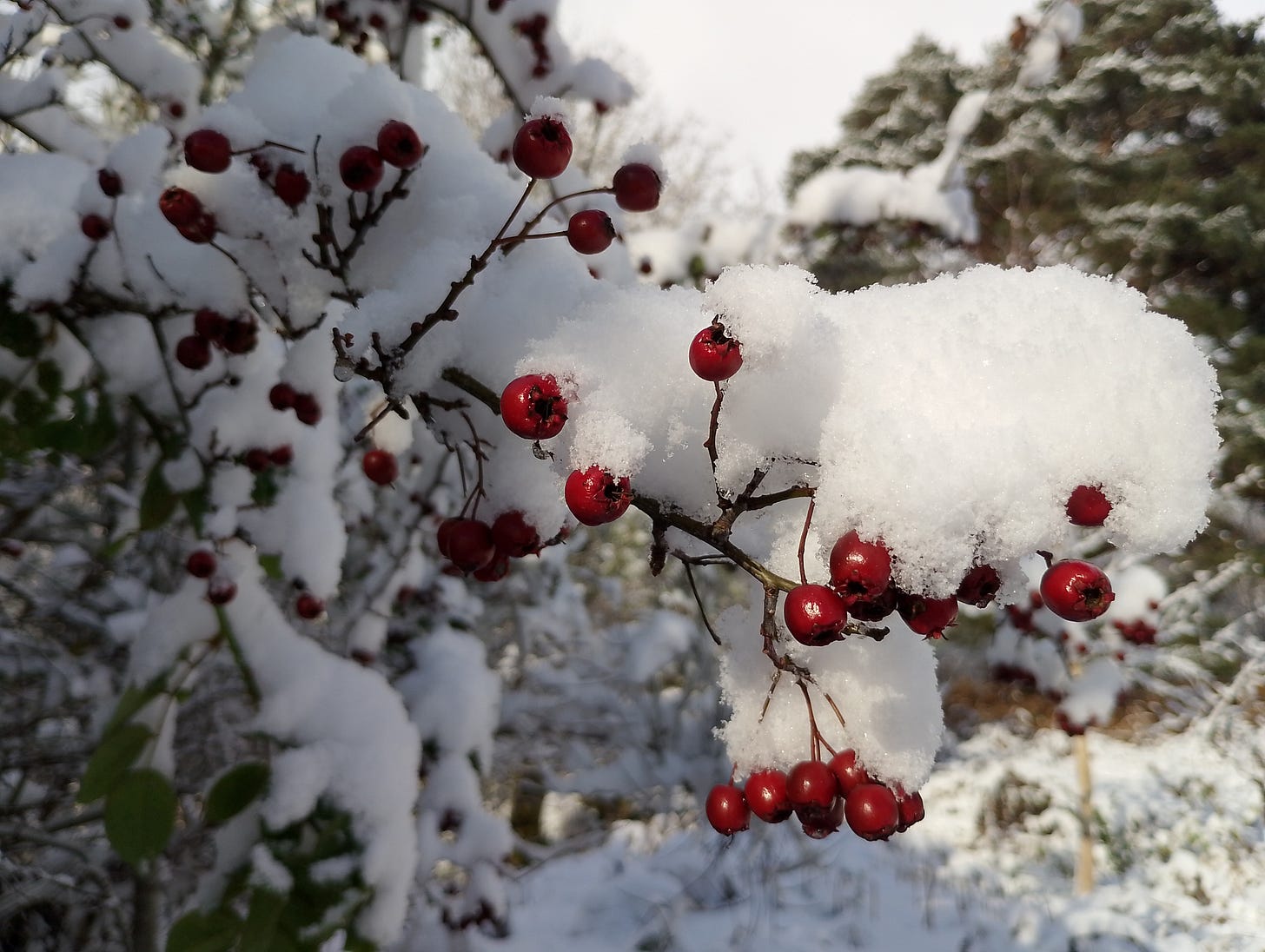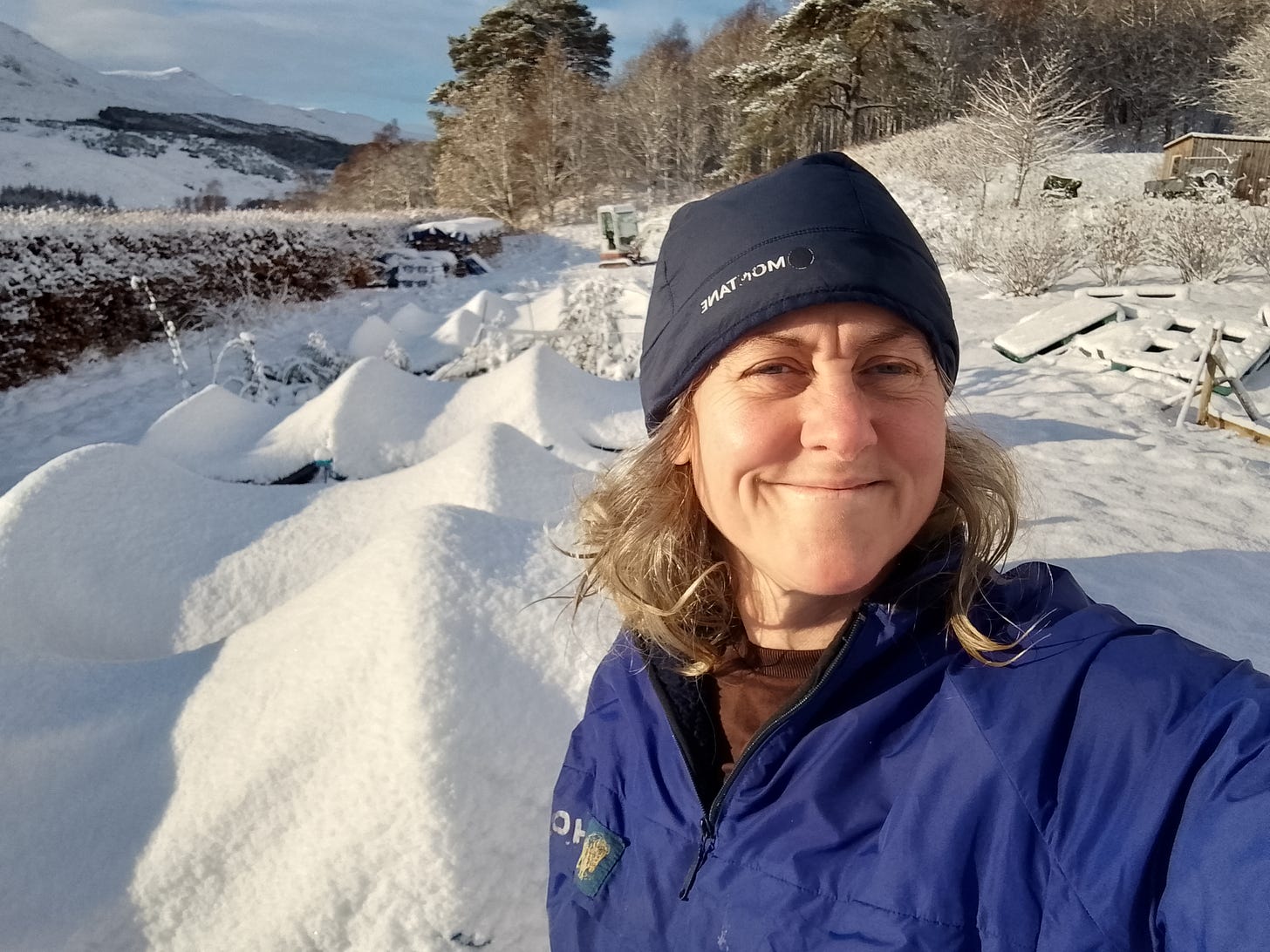Like many others in Highland the first snow of the winter has arrived in my garden this week, a soft, silent visitor draped across the earth.
My vegetables, once robust and green, have surrendered to winter’s grasp, frozen in stillness, beneath their cloche blankets. The arch supports are bowed under the weight of the season’s first snowfall. My hands started to freeze (it was -8C last night) as I brushed the snow away this morning. This left me pondering what is snow, really? It’s more than just frozen water, its more than ice.
Snow isn’t just frozen water, it’s the atmosphere’s imagination at play. High above us, in the clouds, water vapour crystallises around specks of dust and pollen. As these tiny ice crystals tumble and fall, they grow and transform, shaped by the cold air and their journey down to the surface of the earth. Contrary to popular belief, not every snowflake is entirely unique, many share similar forms and their six-sided symmetry is a universal constant.
I thought about the many faces of snow. Powder snow, light and dry, can fall like whispers, drifting across the hillsides to create a pristine, untouched canvas. In colder years, the Highlands are blanketed in this sparkling layer, a dreamscape for skiers.
When temperatures hover just above freezing, the snowflakes partially melt, creating wet snow—this is the kind that sticks together in satisfying lumps. It’s the snow of childhood, perfect for building snowmen or engaging in a festive snowball fight.

Graupel, another type of snow, forms when snowflakes encounter supercooled water droplets in the atmosphere. These droplets, which remain liquid below freezing, collide with the snowflakes and freeze instantly upon contact creating soft pellets. It often has the appearence of tiny polystyrene balls. This type of snow can significantly increase avalanche risk as the graupel reduces friction between snowpack layers, making it easier for upper layers to slide.
And then there are the mornings of hoar frost, when even the smallest twig becomes an icy sculpture. Feathery crystals bloom on the edges of leaves and grasses, catching the light like tiny stars. This frost, though often fleeting, leaves the whole land decorated, nothing left untouched by its artistic fingers.

And the stillness! Have you ever noticed how the quiet adds to the serene beauty of a snowy day? This isn’t an illusion. Snow absorbs sound! The world really is quieter after a fresh snowfall. This phenomenon is due to the unique structure of snow. Freshly fallen snow is made up of a network of ice crystals with lots of tiny air pockets. These air pockets scatter and absorb sound waves, reducing noise and creating the hush you experience in a snowy landscape. The effect is most pronounced with fresh, fluffy snow. As snow ages or becomes compacted, the air pockets diminish, and its sound-absorbing properties are naturally reduced, ending the spell.

As my hands warmed back up inside, a cup of tea steaming before me, I marvelled at how snow transforms the familiar. The garden, so vibrant just a week ago, in the late autumn warmth, now lying still. Yet it doesn’t feel lifeless—rather, it feels like its resting.
The snow is insulating the soil, protecting life beneath it from the cold, and will melt into the water that sustains our spring’s new growth.
So yes, snow is more than frozen water. It’s winter’s way of painting the world anew, of reminding us to pause, to notice the beauty in small things and to savour the stillness. It’s a quiet invitation to slow down and for us to rest too, breathe the crisp air, and find joy in the season’s change.
Imogen Furlong, the High Life Highland Countryside Ranger Manager, is known for her enthusiasm, organisation, and drive. Her deep passion for the Scottish Highlands' wildlife and extensive experience in outdoor education and recreation management have been central to this role. Imogen is a practical and collaborative project manager, empowering her teams to work effectively in communities and contribute to local conservation efforts.
We have a number of fascinationg free online talks this winter all about the natural world - why not join us one Thursday evening (GMT)? The first one is tonight and we still have spaces - a donation for the event is gratefully recieved.
Read about tonights talk here:
Blending Science with Art: Discovering the Colours of the Sea
This November, we’re delighted to launch the start of our popular High Life Highland Nature Unveiled winter talk series with an exceptional presentation from guest speaker Dr. Lonneke Goddijn-Murphy, who will explore how science and art merge to reveal the many colours of the sea in her talk,








Lovely post, very interesting too! We're still waiting for our first snow here in Edinburgh!
Lovely snowy blog. I also like how much lighter it makes a darker time of year.